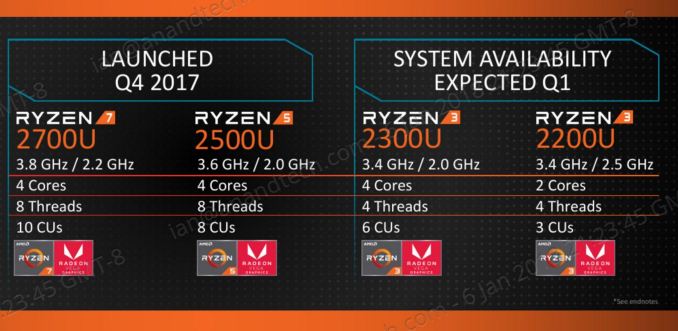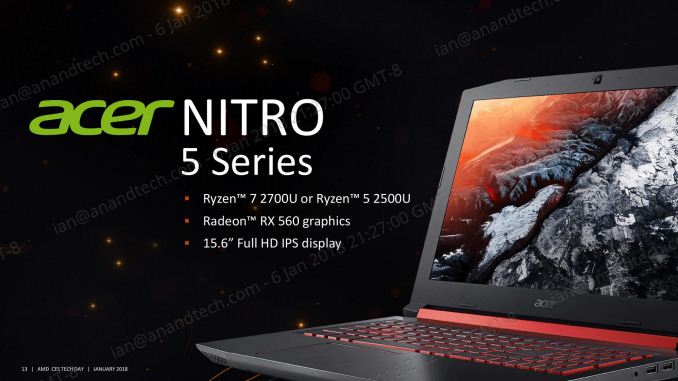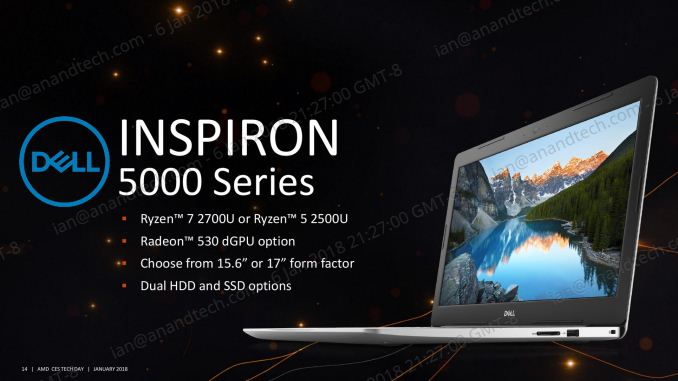AMD Tech Day at CES: 2018 Roadmap Revealed, with Ryzen APUs, Zen+ on 12nm, Vega on 7nm
by Ian Cutress on February 1, 2018 8:45 AM ESTZen Cores and Vega
Ryzen 3 Mobile, Plus More Ryzen Mobile Laptops
The most immediate announcement from AMD is two Ryzen 3 Mobile processors designed to fill out the Mobile stack, and the introduction of Ryzen-based APUs for desktop machines.
At the heart of both of these designs is the combination of AMD’s first-generation Zen cores, specifically four cores in a ‘core complex’, connected to Vega-based graphics integrated into the silicon. The two units are connected via AMD’s Infinity Fabric, designed for high-bandwidth and scale, and a feature that permeates through AMD’s recent product portfolio.
Ryzen Mobile
To date, AMD has already announced two products using this configuration. Both of them are for Ryzen Mobile, specifically the Ryzen 7 2700U and Ryzen 5 2500U, which have already been pre-announced in devices such as the HP Envy x2, the Lenovo Ideapad 720S, and the Acer Swift 3. Only the HP Envy x2 has been launched into the market so far (with mixed reviews due to the OEM design, which draws similar criticisms when equipped with Intel CPUs), with the others to see light in Q1 as well as other OEMs like Dell.
The first announcement is regarding adding more Ryzen Mobile processors to the family to cater for a wider audience. To pair with the Ryzen 7 Mobile and Ryzen 5 Mobile, AMD has two Ryzen 3 Mobile parts which will formally be available on January 9th with expected system availability within Q1.
| AMD Ryzen Mobile APUs | |||||
| Ryzen 7 2700U with Vega 10 |
Ryzen 5 2500U with Vega 8 |
Ryzen 3 2300U with Vega 6 |
Ryzen 3 2200U with Vega 3 |
FX-9800P (2015) |
|
| CPU | 4C / 8T 2.2 GHz Base 3.8 GHz Turbo Zen 14nm |
4C / 8T 2.0 GHz Base 3.8 GHz Turbo Zen 14nm |
4C / 4T 2.0 GHz Base 3.4 GHz Turbo Zen 14nm |
2C / 4T 2.5 GHz Base 3.4 GHz Turbo Zen 14nm |
Dual Module 2.7 GHz Base 3.6 GHz Turbo Excavator 28nm |
| GPU | Vega 10 10 CUs 640 SPs < 1300 MHz |
Vega 8 8 CUs 512 SPs < 1100 MHz |
Vega 6 6 CUs 384 SPs |
Vega 3 3 CUs 192 SPs |
GCN 1.2 8 CUs 512 SPs > 758 MHz |
| TDP | 15W | 15W | 15 W | 15 W | 15W |
| DRAM | Up to DDR4-2400 | DDR4-1866 | |||
| L2 Cache | 512 KB/core | 1 MB/module | |||
| L3 Cache | 1 MB/core | 4 MB/core | - | ||
| PCIe Lanes | ? | ? | ? | ? | 8 x PCIe 3.0 |
| Die Size | 209.78 mm2 | 250.4 mm2 | |||
| Transistors | 4.95 billion | 3.1 billion | |||
| Launch | October 2017 | January 2018 | May 2016 | ||
The Ryzen 3 2300U is a quad-core processor without simultaneous multithreading, which separates it from the other components. The base frequency of 2.0 GHz, a top turbo of 3.4 GHz, and a total of six compute units in the Vega graphics (this equates to 384 streaming processors). The Ryzen 3 2300U shares the same TDP as the other parts, coming in at 15W, and AMD wants to position this as a high-performance part for eSports capable notebooks, handily beating anything from Intel’s 7th Generation family.
The Ryzen 3 2200U is the only dual core component in AMD’s entire Ryzen product line, although it does have simultaneous multithreading to give it four threads in total. Having two fewer cores to fire up does give it a boost on the base frequency, coming in at 2.5 GHz, but the turbo frequency matches the other Ryzen 3 at 3.4 GHz. The 2200U is certainly the processor bringing up the rear, with only three compute units (192 streaming processors) in total, and helping AMD shift some of the processors that are not binned as aggressively as the higher-performance units.
AMD is promoting these two processors as capable elements of an entry level 15W notebook that can process DirectX 12, offer advanced video features, and be used in aesthetically pleasing designs with a long battery life, including 2-in-1s, ultrathin notebooks, and gaming laptops.
New Devices
Not to be content with just announcing a couple of new Ryzen Mobile processors, AMD was eager to promote new mobile devices that will be using Ryzen Mobile. To accompany the HP Envy x360, the Lenovo Ideapad 720S, and the Acer Swift 3, Q1 will see the launch of a new HP (under embargo until later this week), the Acer Nitro 5 series, and the Dell Inspiron 5000 series.
Acer’s Nitro line of laptops is typically aimed at the gaming crowd. The Nitro 5 dictates a 15.6-inch display, which in this case is a 1920x1080 IPS panel. Acer will use the pre-announced higher-end APUs, the Ryzen 7 2700U and Ryzen 5 2500U, but will also be pairing this with a Radeon RX 560 graphics chip. We were told by AMD that the integrated graphics and discrete graphics will be used in a switching context: for video playback, the lower power integrated graphics is used and the discrete is disabled, however the discrete graphics is fired up for gaming work. For compute, or for games that support multi-adaptor DirectX 12 technologies, both the integrated graphics and the discrete graphics should be available, however this is up to the game/software to implement.
The Dell Inspiron lines are more home/small-medium business-oriented devices, and here Dell is also using the Ryzen 7 2700U and Ryzen 5 2500U processors to offer peak Mobile APU performance. Designed more as a workhorse than for aesthetics, the Inspiron 5000 will offer AMD parts with 15.6-inch and 17-inch displays in a chassis that can support dual HDD/SSD options. The unit also comes with an optional Radeon 530 discrete GPU, which has 384 compute units based on AMD’s older GCN 1.0 architecture. This comes across as very odd, given that even the Ryzen 5 has 512 compute units of the newer Vega architecture. I can only assume that this provides extra displays for very specific customers, though for most it would seem an overly pointless addition.














131 Comments
View All Comments
iwod - Monday, January 8, 2018 - link
Does Vega 7nm necessarily means GF though? I thought the drop of Vega 12nm+ make sense as it would be competing with Ryzen for GF capacity. Given how AMD is doing well and should be even better now when Meltdown is on Intel.I would have thought moving Radeon back to TSMC would be a much better choice.
Outlander_04 - Tuesday, January 9, 2018 - link
TSMC ? Why?It would also mean higher costs for AMD
Holliday75 - Tuesday, January 9, 2018 - link
Just a guess, but based off his comment he suggested that Radeon would be competing for fab space at GF. If reduced capacity for Zen cuts into profits then the extra costs to move might be worth it.Just basing this off of his comment.
Stuka87 - Monday, January 8, 2018 - link
I sure hope Dell comes out with a Precision laptop with AMD stuff. The Inspirons share a lot with the Precisions.Dragonstongue - Monday, January 8, 2018 - link
so it sounds like a "refresh" to RX 500 series which was claimed for 2018 is not happening, that sucks TBH..need a new GPU and many of the "good" RX 570-580s are out of stock or low in stock ballooning their prices, need replace my 7870 sometime soon, 460/560 will not cut it, and spending ~$80 more than should is a no go for me to replace it. 1280 shader 256 bit bus with a bump in ROP/TMU at 170w maximum (heavily overclocked) 7870 was THE "mainstream" performance card for its generation, have not seen AMD nor Nv release one that is "comparable" either higher performance (higher price) or less performance (similar price) but nothing to supplant it really.
Good news though, just shows that Zen+ (12nm) is/was not Zen2 (was always to be on 7nm) which I told off many a 3rd party "review" site claiming it would be ^.^
Sttm - Monday, January 8, 2018 - link
The GPU roadmap is so sad. AMD barely has a GPU that can top the GTX1080 I bought Summer 2016, and won't have a truly superior offering until 2019.My only hope of a proper upgrade is now Volta, and Nvidia will have no reason not to price gouge with this pathetic competition!
Arbie - Monday, January 8, 2018 - link
@Sttm - I'm also sorry that AMD's graphics wasn't a win in 2017. But I wonder what games you could possibly find good enough to warrant moving "up" from a 1080? The tiny increase in quality or FPS would only be meaningful - maybe - on a game you love that has top-notch graphics AND doesn't look good enough on your current card. I only wish there was something even close to that for me.gerz1219 - Thursday, February 1, 2018 - link
Plenty of modern games play somewhat smoothly at 4K on a 1080 Ti, but could use a bump up in fps. Once you see 4k gaming, it's kind of hard to unsee, which is why I haven't bothered to buy a 1440p gaming panel to complement my professional panel. I'd gladly pay another $700 + the cost of a 4K Gsync/Freesync monitor next year to upgrade the 1080 Ti to something that can crush any game at 4K, but it doesn't look like that product will hit the market in 2019 because AMD is so far behind, and everyone's making tons of money selling GPUs for crypto.sld - Monday, January 8, 2018 - link
Those who buy price gouging items walk into it willingly. Gsync vs Freesync, for example.Santoval - Monday, January 8, 2018 - link
I hope you'll get better soon Ian. I don't think I would be able to type a single sentence if I were in your shoes, I have to admit am impressed by your resilience.